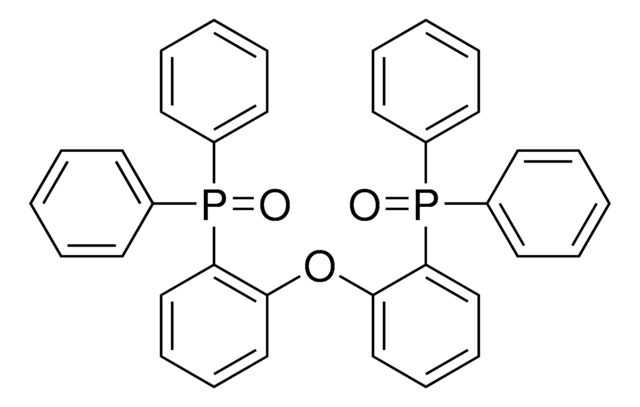If this product has an expiration or retest date, it will be shown on the Certificate of Analysis (COA, CofA). If there is no retest or expiration date listed on the product's COA, we do not have suitable stability data to determine a shelf life. For these products, the only date on the COA will be the release date; a retest, expiration, or use-by-date will not be displayed.
For all products, we recommend handling per defined conditions as printed in our product literature and website product descriptions. We recommend that products should be routinely inspected by customers to ensure they perform as expected.
For products without retest or expiration dates, our standard warranty of 1 year from the date of shipment is applicable.
For more information, please refer to the Product Dating Information document: https://www.sigmaaldrich.com/deepweb/assets/sigmaaldrich/marketing/global/documents/449/386/product-dating-information-mk.pdf
806781
TPBi
Synonym(s):
2,2′,2"-(1,3,5-Benzinetriyl)-tris(1-phenyl-1-H-benzimidazole)
About This Item
Recommended Products
Assay
≥99.5% (HPLC)
Quality Level
form
powder
mp
272-277 °C
Orbital energy
HOMO 6.2 eV
LUMO 2.7 eV
OLED Device Performance
ITO/MoO3/NPB/Cz-BTPE/TPBi/LiF/Al (ref 2)
- Color: blue
- Max. Luminance: 9911 Cd/m2
- Max. EQE: 1.9 %
- Turn-On Voltage: 4.9 V
ITO/MoO3/NPB/Ph-BTPE/TPBi/LiF/Al
- Color: blue
- Max. Luminance: 6497 Cd/m2
- Max. EQE: 1.9 %
- Turn-On Voltage: 5.3 V
ITO/MoO3/NPB/isopro-BTPE/TPBi/LiF/Al(ref 2)
- Color: blue
- Max. Luminance: 1127 Cd/m2
- Max. EQE: 1.7 %
- Turn-On Voltage: 5.3 V
ITO/MoO3/NPB/methyl-BTPE/TPBi/LiF/Al (ref 2)
- Color: blue
- Max. Luminance: 1976 Cd/m2
- Max. EQE: 1.3 %
- Turn-On Voltage: 5.3 V
SMILES string
C1(C2=NC(C=CC=C3)=C3N2C4=CC=CC=C4)=CC(C5=NC(C=CC=C6)=C6N5C7=CC=CC=C7)=CC(C8=NC(C=CC=C9)=C9N8C%10=CC=CC=C%10)=C1
InChI
1S/C45H30N6/c1-4-16-34(17-5-1)49-40-25-13-10-22-37(40)46-43(49)31-28-32(44-47-38-23-11-14-26-41(38)50(44)35-18-6-2-7-19-35)30-33(29-31)45-48-39-24-12-15-27-42(39)51(45)36-20-8-3-9-21-36/h1-30H
InChI key
GEQBRULPNIVQPP-UHFFFAOYSA-N
Looking for similar products? Visit Product Comparison Guide
General description
The increase in power conversion efficiency of the device on the addition of TBPi is attributed to the following reasons:
- Preventing exciton from quenching at the acceptor/cathode interface.
- Acting as an optical spacer.
- Forming a passivating layer.[2]
Application
Storage Class Code
11 - Combustible Solids
WGK
WGK 3
Flash Point(F)
Not applicable
Flash Point(C)
Not applicable
Choose from one of the most recent versions:
Already Own This Product?
Find documentation for the products that you have recently purchased in the Document Library.
Customers Also Viewed
Articles
Organic Light-emitting Diodes (OLEDs) are solid-state devices that transform electrical energy into light. OLEDs are considered the next generation technology for high-resolution flexible displays and solid state lighting, attracting intense scientific and industrial interest.
Related Content
Organic electronics utilizes organic conductors and semiconductors for applications in organic photovoltaics, organic light-emitting diodes, and organic field-effect transistors.
Organic electronics utilizes organic conductors and semiconductors for applications in organic photovoltaics, organic light-emitting diodes, and organic field-effect transistors.
Organic electronics utilizes organic conductors and semiconductors for applications in organic photovoltaics, organic light-emitting diodes, and organic field-effect transistors.
Organic electronics utilizes organic conductors and semiconductors for applications in organic photovoltaics, organic light-emitting diodes, and organic field-effect transistors.
-
How can I determine the shelf life / expiration / retest date of this product?
1 answer-
Helpful?
-
-
How is shipping temperature determined? And how is it related to the product storage temperature?
1 answer-
Products may be shipped at a different temperature than the recommended long-term storage temperature. If the product quality is sensitive to short-term exposure to conditions other than the recommended long-term storage, it will be shipped on wet or dry-ice. If the product quality is NOT affected by short-term exposure to conditions other than the recommended long-term storage, it will be shipped at ambient temperature. As shipping routes are configured for minimum transit times, shipping at ambient temperature helps control shipping costs for our customers. For more information, please refer to the Storage and Transport Conditions document: https://www.sigmaaldrich.com/deepweb/assets/sigmaaldrich/marketing/global/documents/316/622/storage-transport-conditions-mk.pdf
Helpful?
-
Active Filters
Our team of scientists has experience in all areas of research including Life Science, Material Science, Chemical Synthesis, Chromatography, Analytical and many others.
Contact Technical Service









